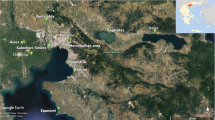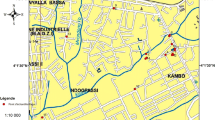Abstract
Mosquitoes are important vectors of several diseases including malaria in humans. Effective control on mosquito-borne diseases requires ecological studies on mosquitoes. The study was based on adult collections of mosquitoes from human dwellings, cattle sheds, bathrooms and animal baits, and on larval collections from breeding sites in the study village during October 1996-September 1997, to determine their seasonal variation in species composition and relative abundance of mosquitoes. Five genera of mosquitoes, including Anopheles (six), Culex (five), Aedes (two), Culiseta (one) and Mansonia (one) were found. Overall, Culex quinquefasciatus was 88%, while, remaining each species accounted for ≤ 3.1% of the total mosquito fauna collected. Anopheles species constituted 2.8% of the total mosquitoes collected with An. stephensi showed the highest 47.8%, while An. fluviatilis showed lowest (0.6%). Cattle sheds harboured 4.4 times more mosquitoes compared to those collected from the human dwellings. Abundance was lowest in February, through spring, and reached its peak in May, but decreased again in July. An. stephensi was found during May–October. Aedes caspius and Ae. albopictus were abundant in October. An. culicifacies was present in low numbers during May–November, Mansonia unifromis was collected only from animal bait. Most of the species (13 out of 15) were collected as adults, whereas Culiseta logiaerolata and Cx. vagans were collected only as immatures. Culex quinquefasciatus was the most abundant species found all over the year. While other species have specific seasonality. An. stephensi was found from May through October. Abundance of mosquitoes was lowest in late winter and reached its peak in early summer.

Similar content being viewed by others
References
Akram W, Hafeez F, Naeemullah KYK, Hussain A, Lee JJ (2009) Seasonal distribution and species composition of daytime biting mosquitoes. Entomol Res 39:107–113
Ali N, Rasheed SB (2009) Determination of species composition of mosquitoes found in Palosai Stream, Peshawar. Pak Entomolo 31(1):47–51
Aslamkhan M, Salman C (1969) The bionomics of the mosquitoes of the Changa Manga National Forest, West Pakistan. Pak J Zool 1:183–205
Banu S, Hu W, Hurst C, Guo Y, Islam MZ, Tong S (2012) Space-time clusters of dengue fever in Bangladesh. Trop Med Int Health 17(9):1086–1091
Barraud PJ (1934) The fauna of British India, including Ceylon and Burma, Diptera, family Culicidae. Tribes Megarhinini and Culicini, Taylor and Francis, London, XXVIII, p 463
Benjamini Y, Hochberg Y (1995) Controlling the false discovery rate: a practical and powerful approach to multiple testing. J Roy Stat Soc B 57:289–300
Brady OJ, Gething PW, Bhatt S, Messina JP, Brownstein JS et al (2012) Refining the global spatial limits of dengue virus transmission by evidence-based consensus. PLoS Negl Trop Dis 6(8):e1760
Brady OJ, Hay SI (2020) The global expansion of dengue: How Aedes aegypti mosquitoes enabled the first pandemic arbovirus. Annu Rev Entomol 65:191–208
CDC (2016) Epidemiology. URL: CDC, GA, USA. https://www.cdc.gov/dengue/epidemiology/index.html. Accessed 13 Dec 2016
Chaves LF, Keogh CL, Nguyen AM, Decker GM, Vazquez-Prokopec GM, Kitron UD (2010) Combined sewage overflow accelerates immature development and increases body size in the urban mosquito Culex quinquefasciatus. J Appl Entomol 135:611–620
Christophers SR (1933) The fauna of British India, including Ceylon and Burma. Diptera family culicidae. Tribe Anophelinae. Taylor and Francis, London, p 4
Dhimal M, Ahrens B, Kuch U (2014) Species composition, seasonal occurrence, habitat preference and altitudinal distribution of malaria and other disease vectors in eastern Nepal. Parasit Vecto 7:540
Egid BR, Coulibaly M, Dadzie SK, Kamgang B, McCall PJ, Sedda L, Toe KH, Wilson AL (2022) Review of the ecology and behaviour of Aedes aegypti and Aedes albopictus in Western Africa and implications for vector control. Curr Res in Parasito & Vect-Bor Dis 2:100074. https://doi.org/10.1016/j.crpvbd.2021.100074
Ewing DA, Cobbold CA, Purse BV, Nunn MA, White SM (2016) Modelling the effect of temperature on the seasonal population dynamics of temperate mosquitoes. J Theor Biol 400:65–79
Fagbohun IK, Idowu ET, Awolola TS, Otubanjo OA (2020) Seasonal abundance and larval habitats characterization of mosquito species in Lagos State, Nigeria. Scienti Afric 10:e00656. https://doi.org/10.1016/j.sciaf.2020.e00656
Fofana A, Gendrin M, Romoli O, Yarbanga GAB, Ouédraogo GA, Yerbanga RS, Ouédraogo J-B (2021) Analyzing gut microbiota composition in individual Anopheles mosquitoes after experimental treatment. iScience 24(24):103416. https://doi.org/10.1016/j.isci.2021.103416
Franklinos LHV, Jones KE, Redding DW, Abubakar I (2019) The effect of global change on mosquito-borne disease. Lancet Infect Dis 19(9):302–312
Frontier Post (2019) Dengue virus diagnosed in 16,000 people across Pakistan, report, Frontier Post. https://reliefweb.int/report/pakistan/dengue-virus-diagnosed-16000-people-across-pakistan. dated 28 Sept 2019
Gubler DJ (1989) In: Monath, T.P. (Ed.), Dengue: The Arboviruses: Epidemiology and Ecology, CRC Press, Florida 2
Gubler DJ (2002) The global emergence/resurgence of arboviral diseases as public health problems. Archi Med Res 33:330–342
Guillena JB, Opena EL, Baguio ML (2010) Prevalence of Dengue Fever (DF) and Dengue Hemorrhagic Fever (DHF): a description and forecasting. in Proceedings of the 11th National Convention on Statistics (NCS ’10), p. 16
Hawley WA (1988) The biology of Aedes albopictus. J Am Mosq Control Assoc Suppl 1:1–39
Ilahi A, Suleman M (2013) Species composition and relative abundance of mosquitoes in Swat, Pakistan. Int J Innov Appl Stud 2(4):454–463
Islam S, Haque E, Hossain S, Rochon K (2019) Role of container type, behavioural, and ecological factors in Aedes pupal production in Dhaka, Bangladesh: An application of zero-inflated negative binomial model. Act Trop 193:50–59
Kamimura K, Takasu T, Ahmed A, Ahmed A (1986) A Survey of Mosquitoes in Karachi Area, Pakistan. J Pak Med Assoc 36:182–188
Khan SU, Khan RA (2018) Characterisation of breeding sites of anopheline mosquitoes in District Bannu, KPK, Pakistan. J Pak Med Assoc 68(2)
Knudsen AB (1995) Global distribution and continuing spread of Aedes albopictus. Parassitolog 37(2–3):91–97
Lambrechts L, Scott TW, Gubler DJ (2010) Consequences of the Expanding Global Distribution of Aedes albopictus for Dengue Virus Transmission. PLoS Negl Trop Dis 4(5):e646. https://doi.org/10.1371/journal.pntd.0000646
Madzlan F, Dom NC, Chua ST, Zakaria N (2016) Breeding Characteristics of Aedes Mosquitoes in Dengue Risk Area. Procedia Soc Behav Sci 234:164–172
Manzoor F, Shabbir R, Sana M, Nazir S, Khan MA (2020) Determination of species composition of mosquitoes in Lahore, Pakistan. J Arthrop Borne Dis 14(1):106–115
Merritt RW, Dadd RH, Walker ED (1992) Feeding behavior, natural food, and nutritional relationships of larval mosquitoes. Annu Rev Entomol 37:349–376
Messina JP, Brady OJ, Golding N, Kraemer MU, Wint GW, Ray SE et al (2019) The current and future global distribution and population at risk of dengue. Nat Microbiol 4:1508–1515
Mukhtar M, Herrel N, Amerasinghe FP, Ensink J, van der Hoek W, Konradsen F (2003) Role of waste water irrigation in mosquito breeding in South Punjab, Pakistan. Southea Asia J Trop Med Pub Heal 34(1)
Nasir S, Jabeen F, Abbas S, Nasir I, Debboun M (2017) Effect of climatic conditions and water bodies on population dynamics of the Dengue Vector, Aedes aegypti (Diptera: Culicidae). J Arthropod-Borne Dis 11(1):50–59
Nikookar SH, Fazeli-Dinan M, Azari-Hamidian S, Nasab SNM, Aarabi M, Ziapour SP, Enayati A, Hemingway J (2018) Fauna, ecological characteristics, and checklist of the mosquitoes in Mazandaran Province. Northern Iran J Med Entomol 20(10):1–12
Pal AR, Aziz A (1985) A survey of malaria parasite and anopheline mosquitoes in Rawalpindi-Islamabad area. J Pak Medi Associ 69–71
Paul KK, Dhar-Chowdhury P, Haque CE, Al-Amin HM, Goswami DR, Kafi MAH et al (2018) Risk factors for the presence of dengue vector mosquitoes, and determinants of their prevalence and larval site selection in Dhaka, Bangladesh. PLoS One 13(6):e0199457
Phuanukoonnon S, Mueller I, Bryan JH (2005) Effectiveness of dengue control practices in household water containers in Northeast Thailand. Trop Med Int Health 10:755–763
Prasad A, Kumar A (2020) Susceptibility status of dengue vector Aedes aegypti (L.) against various larvicides and insecticides in Udaipur district of Southern Rajasthan, India. Int J Entomol Res 5(1):74–77
Qutubuddin M (1960) The mosquito fauna of Kohat-Hangu Valley. West Pakistan Mosq News 20:355–361
Regis LN, Acioli RV, Silveira JC Jr, de Melo-Santos MA, da Cunha MC, Souza F et al (2014) Characterization of the spatial and temporal dynamics of the dengue vector population established in urban areas of Fernando de Noronha, a Brazilian oceanic island. Acta Trop 137:80–87
Rehman M, Mutalib A (1976) Determination of Malaria Transmission in Central Part of Karachi City and Incrimination of An. stephensi as the Vector. Pak J Health 17:73–84
Reisen WK (1978) A quantitative mosquito survey of seven villages in Punjab province, Pakistan with notes on bionomics, sampling methods and the effects of insecticide. Southea. Asi J Trop Med Pub Heal 9:587–601
Reisen WK, Boreham PFL (1982) Estimates of Malaria vectorial capacity for Anopheles culicifacies and Anopheles stephensi in Rural Punjab Province Pakistan. J Med Entomol 19(1):98–103
Reisen WK, Boreham PFL (1979) Host selection patterns of some Pakistan mosquitoes. Am J Trop Med Hyg 28:408–421
Rigau-Perez JG, Clark GG, Gubler DJ, Reiter P, Sanders EJ, Vorndam AV (1998) Dengue and Dengue Haemorrhagic Fever Lanc 352:971–977
Schaffner F, Angel G, Geoffroy B, Hervy JP, Rhaeim A (2001) The mosquitoes of Europe/Les moustiquesd’Europe [computer program]. IRD editions, Montpellier
Scott TW, Morrison AC, Lorenz LH, Clark GG, Strickman D, Kittayapong P, Zhou H, Edman JD (2000) Longitudinal studies of Aedes aegypti (Diptera: Culicidae) in Thailand and Puerto Rico: Population dynamics. J Med Entomol 37:77–88
Shabbir W, Pilz J, Naeem A (2020) A spatial-temporal study for the spread of dengue depending on climate factors in Pakistan (2006–2017). BMC Public Health 20:995
Suleman M, Khan S, Khalid M (1993) Ecology of mosquitoes in Peshawar Valley and adjoining areas: species composition and relative abundanc. Pak J Zool 25(4):321–328
Tariq ZK (1967) A preliminary report of the mosquitoes in Gilgit Agency area. Pak J Sci 19:47–56
Ullah N, Akram W, Suhail A, Rana SA (2010) Grouping of different mosquito species on the bases of larval habitats. Pak J Agr Sci 47(2):124–131
Acknowledgements
I would like to sincerely thank all my younger brothers and sisters for helping me in the collection of both immature and adult mosquitoes. I am grateful to Professor Dr Muhammad Suleman for his help in the mosquito’s identification and writing the article, as well as for the provision of laboratory facilities for conducting research at the Department of Zoology, University of Peshawar. I am also thankful to Jos Feys, senior research fellow in the Department of Kinesiology at the KU Leuven University (Catholic University of Leuven, Belgium) for statistical analysis of the data. Thanks to the staff of the Agriculture Research Station, Serai Naurang, Lakki Marwat (Pakistan) for the provision of the meteorological data for the year 1996-97.
Author information
Authors and Affiliations
Corresponding author
Ethics declarations
Conflict of interest
Author declare no conflict of interest.
Additional information
Publisher's Note
Springer Nature remains neutral with regard to jurisdictional claims in published maps and institutional affiliations.
Rights and permissions
About this article
Cite this article
Khan, M.A. Seasonal variation in species composition and relative abundance of mosquitoes in the District Bannu, Khyber Pakhtunkhwa, Pakistan: prospects of dengue fever in the study area. Int J Trop Insect Sci 42, 2221–2231 (2022). https://doi.org/10.1007/s42690-022-00744-3
Received:
Accepted:
Published:
Issue Date:
DOI: https://doi.org/10.1007/s42690-022-00744-3




